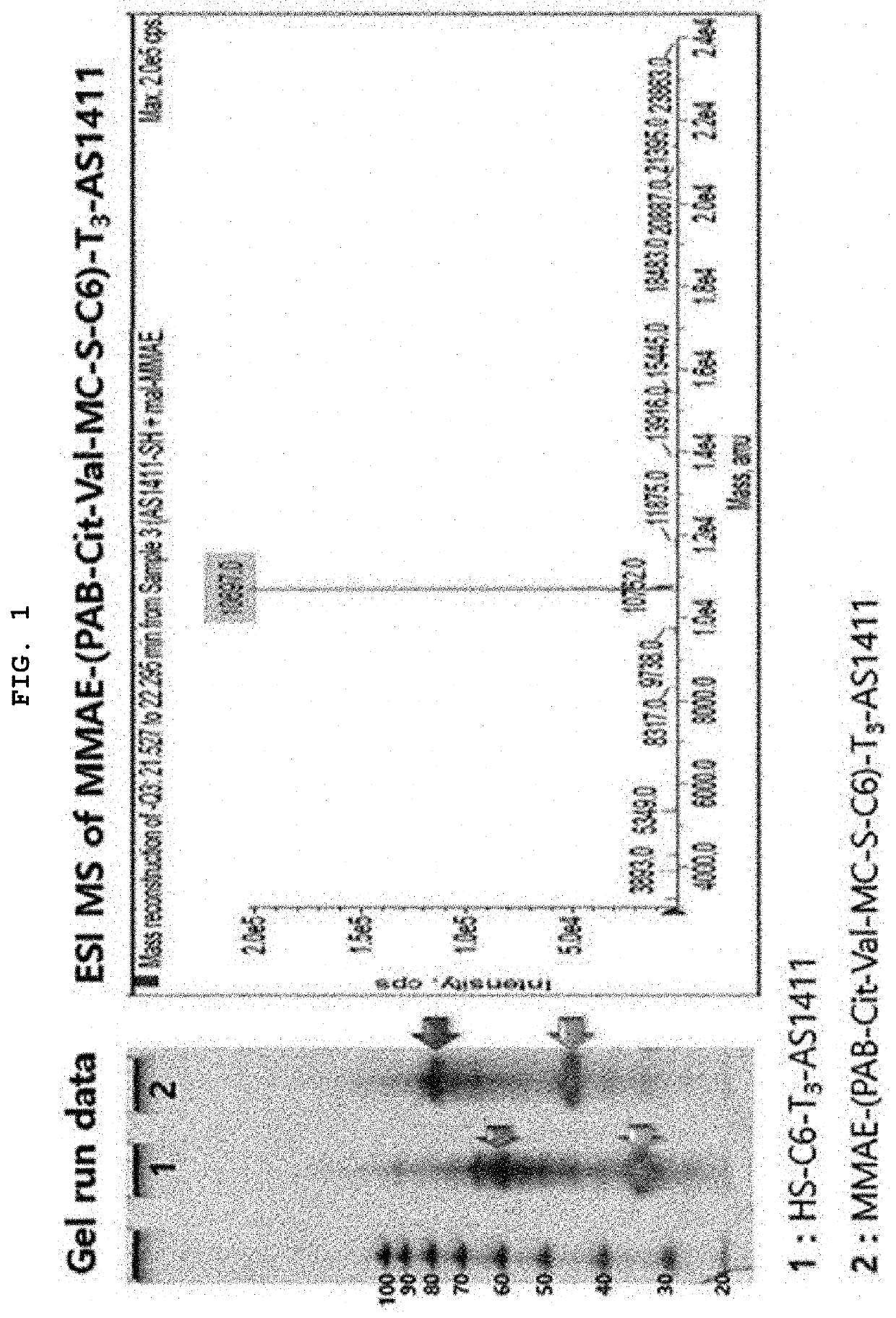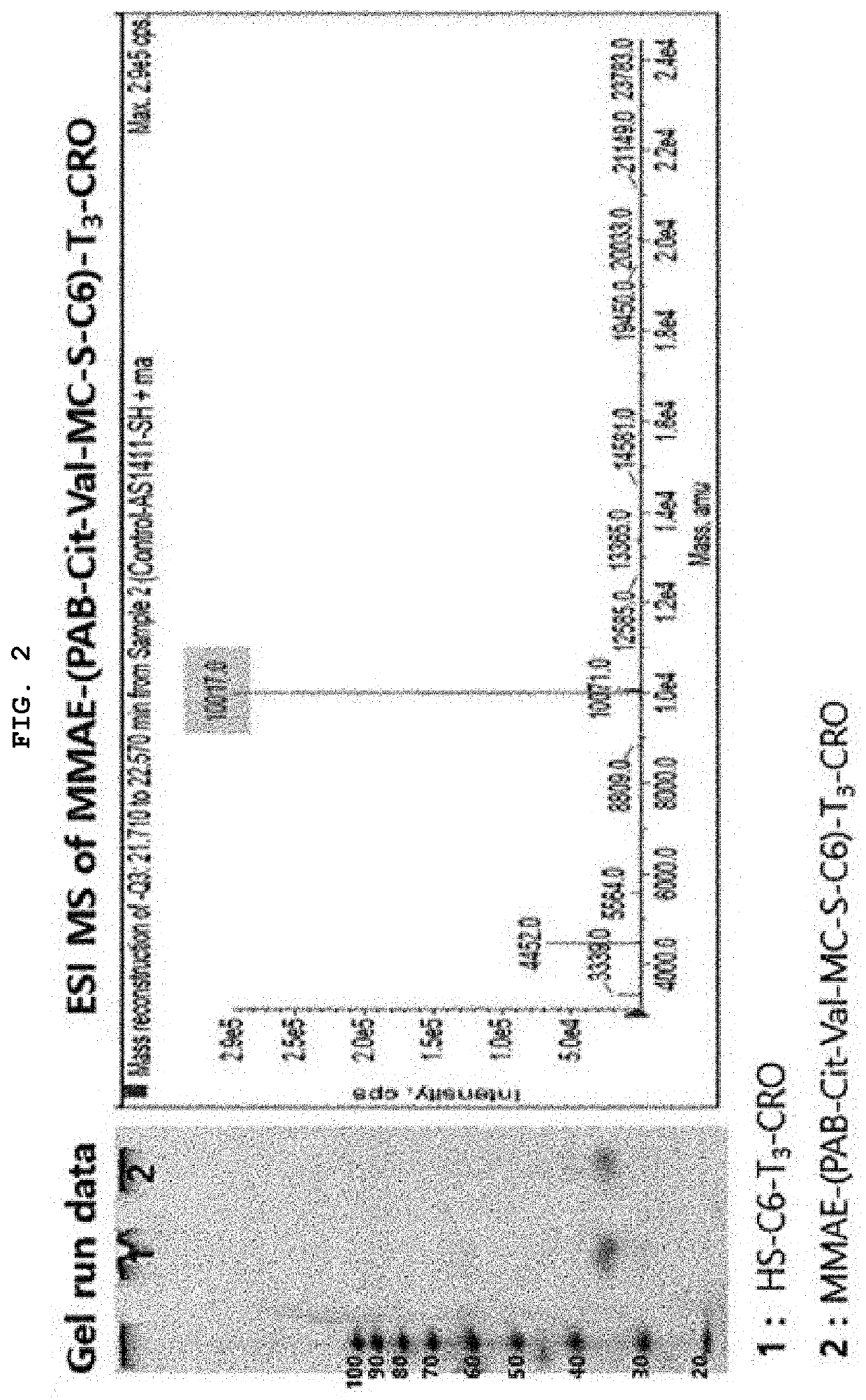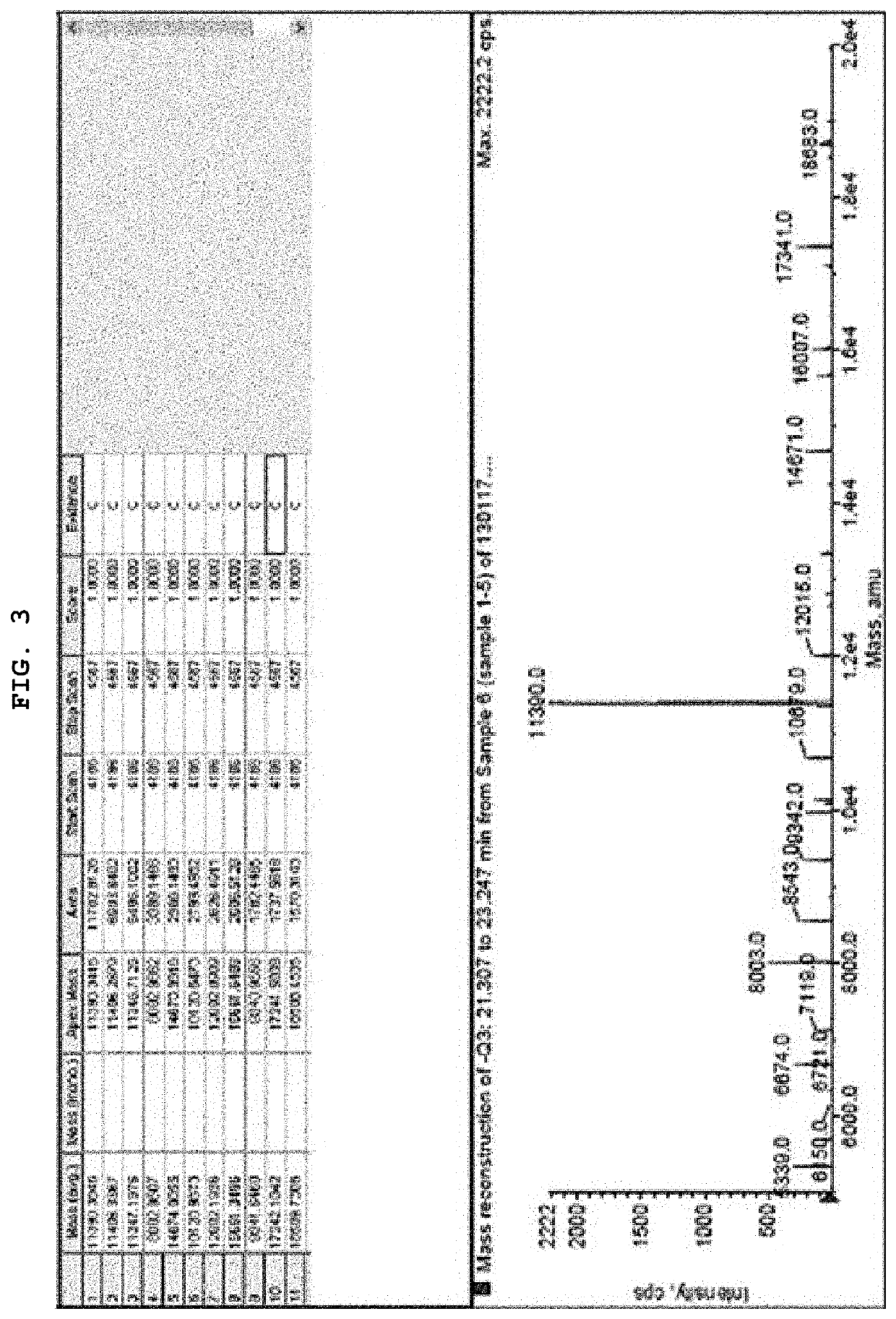Aptamer-drug conjugate and use thereof
a technology of aptamer-drug conjugates and aptamer-drug conjugates, which is applied in the direction of drug compositions, heterocyclic compound active ingredients, biochemistry apparatus and processes, etc., can solve the problems of high toxicity of aptamer-drug conjugates, inability to distinguish tumor cells or tumor tissues from normal cells, etc., to achieve effective cancer targeted treatment
- Summary
- Abstract
- Description
- Claims
- Application Information
AI Technical Summary
Benefits of technology
Problems solved by technology
Method used
Image
Examples
example 1
[0061]Synthesis of MMAE-(PAB-Cit-Val-MC-S-C6)-T3-AS1411 [AS1411-MMAE Conjugate]
[0062]By reacting maleimidocaproyl-valine-citrulline-p-aminobenzoyloxycarbonylmonomethyl auristatin E [MC-Val-Cit-PAB-MMAE] with HS-C6-tttggtggtggtggttgtggtggtggtgg (SEQ ID NO: 2) [HS-C6-T3-AS1411], monomethyl auristatin E-p-aminobenzoyloxycarbonyl-citrulline-valine-Mal-S-C6-tttggtggtggtggttgtggtggtggtgg (SEQ ID NO: 2) [MMAE-(PAB-Cit-Val-MC-S-C6)-T3-AS1411] was synthesized. In other words, RSS-C6-tttggtggtggtggttgtggtggtggtgg (SEQ ID NO: 2) [RSS-C6-T3-AS1411] was subjected to reductive reaction in the presence of DTT for about 3 hours, and the remaining DTT was removed by a centrifuge and replaced with an SB17 buffer solution, resulting in HS-C6-tttggtggtggtggttgtggtggtggtgg (SEQ ID NO: 2) [HS-C6-T3-AS1411]. After putting MC-Val-Cit-PAB-MMAE dissolved in a small amount of DMSO into the resultant product, the mixture was shaken overnight. Separation / purification were performed through reverse phase HPLC (W...
example 2
[0065]Synthesis of MMAE-(PAB-Cit-Val-MC-S-C6)-T3-CRO
[0066]By reacting maleimidocaproyl-valine-citrulline-p-aminobenzoyloxycarbonylmonomethyl auristatin E [MC-Val-Cit-PAB-MMAE] with HS-C6-tttcctcctcctccttctcctcctcctcc (SEQ ID NO: 3) [HS-C6-T3-CRO], monomethyl auristatin E-p-aminobenzoyloxycarbonyl-citrulline-valine-Mal-S-C6-tttcctcctcctccttctcctcctcctcc (SEQ ID NO: 3) [MMAE-(PAB-Cit-Val-MC-S-C6)-T3-CRO] was synthesized. In other words, RSS-C6-tttcctcctcctccttctcctcctcctcc (SEQ ID NO: 3) [RSS-C6-T3-CRO) was subjected to reductive reaction in the presence of DTT for about 3 hours, and the remaining DTT was removed by a centrifuge and replaced with an SB17 buffer solution, resulting in HS-C6-tttcctcctcctccttctcctcctcctcc (SEQ ID NO: 3) [HS-C6-T3-CRO). After putting MC-Val-Cit-PAB-MMAE dissolved in a small amount of DMSO into the resultant product, the mixture was shaken overnight. Separation / purification were performed through reverse phase HPLC (Waters-Xbridge OST C18 10×50 mm, 65, TEA...
example 3
[0069]Synthesis of 12,13-(MMAE-PAB-Cit-Val-MC-S-C6)2-AS1411 and 12 or 13-(MMAE-PAB-Cit-Val-MC-S-C6)-AS1411
[0070]By reacting maleimidocaproyl-valine-citrulline-p-aminobenzoyloxycarbonylmonomethyl auristatin E [MC-Val-Cit-PAB-MMAE] with ggtggtggtggu (SEQ ID NO: 4) [5-N-(6-(3-thiopropanoyl)-aminohexyl)-3-acrylamido]u[5-N-(6-(3-thiopropanoyl)-aminohexyl)-3-acrylamido]gtggtggtggtgg (SEQ ID NO: 6) [12,13-(HS-C6)2-AS1411], ggtggtggtggu (SEQ ID NO: 4) [5-N-(6-(3-monomethyl auristatin-p-aminobenzoyloxycarbonyl-citrulline-valine-Mal-thiopropanoyl)-aminohexyl)-3-acrylamido]u[5-N-(6-(3-monomethyl auristatin-p-aminobenzoyloxycarbonyl-citrulline-valine-Mal-thiopropanoyl)-aminohexyl)-3-acrylamido]gtggtggtggtgg (SEQ ID NO: 6) [12,13-(MMAE-PAB-Cit-Val-MC-S-C6)2-AS1411], and ggtggtggtggu (SEQ ID NO: 4) [5-N-(6-(3-monomethyl auristatin-p-aminobenzoyloxycarbonyl-citrulline-valine-Mal-thiopropanoyl)-aminohexyl)-3-acrylamido]ugtggtggtggtgg (SEQ ID NO: 5)] [12 or 13-(MMAE-PAB-Cit-Val-MC-S-C6)-AS1411] were...
PUM
| Property | Measurement | Unit |
|---|---|---|
| temperature | aaaaa | aaaaa |
| diameter | aaaaa | aaaaa |
| anticancer drug-resistance | aaaaa | aaaaa |
Abstract
Description
Claims
Application Information
 Login to View More
Login to View More - R&D
- Intellectual Property
- Life Sciences
- Materials
- Tech Scout
- Unparalleled Data Quality
- Higher Quality Content
- 60% Fewer Hallucinations
Browse by: Latest US Patents, China's latest patents, Technical Efficacy Thesaurus, Application Domain, Technology Topic, Popular Technical Reports.
© 2025 PatSnap. All rights reserved.Legal|Privacy policy|Modern Slavery Act Transparency Statement|Sitemap|About US| Contact US: help@patsnap.com



